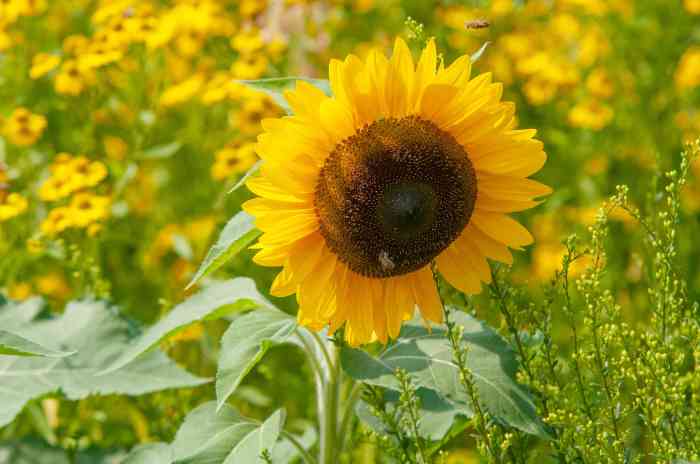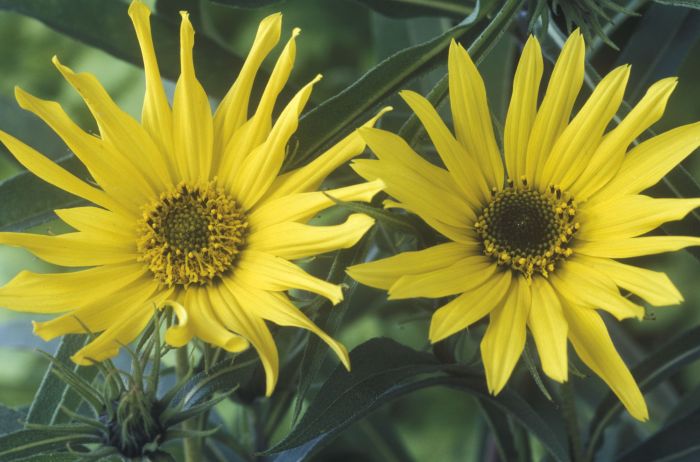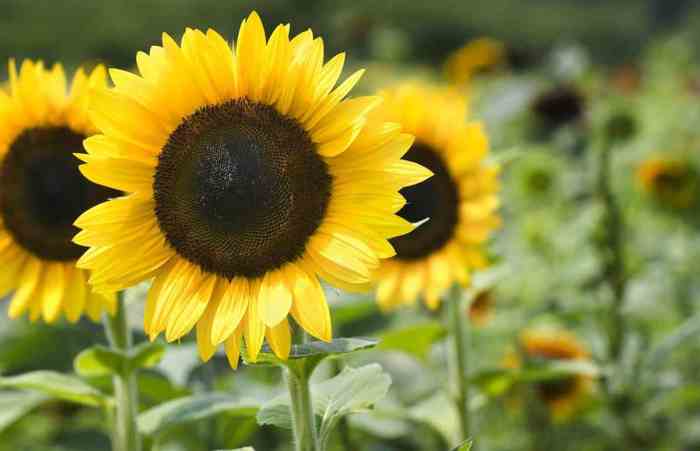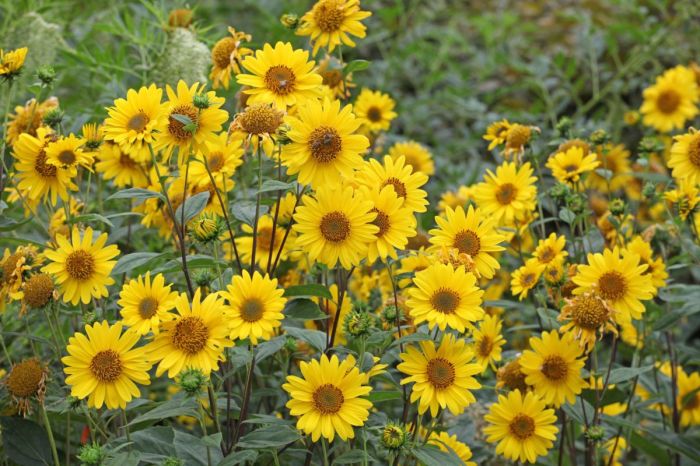Dive into the world of perennial sunflowers, a captivating species that adds enduring beauty and ecological benefits to your garden. From their distinct characteristics to cultivation tips and captivating varieties, this comprehensive guide unveils everything you need to know about these radiant blooms.
Perennial Sunflowers

Perennial sunflowers, unlike their annual counterparts, are long-lived plants that return year after year, providing beauty and ecological benefits to gardens and landscapes. These resilient plants possess unique characteristics that set them apart from annual varieties.
Physical Attributes
Perennial sunflowers exhibit a range of physical attributes that contribute to their distinctive appearance. They typically grow taller than annual varieties, reaching heights of 3-6 feet or more. Their foliage is characterized by large, deeply lobed leaves that form a dense, bushy clump at the base of the plant.
The flower heads of perennial sunflowers are smaller in size compared to annual varieties, typically ranging from 2-4 inches in diameter. However, they bloom profusely, producing an abundance of bright, cheerful flowers throughout the summer and into the fall.
Adaptability
Perennial sunflowers are known for their adaptability to various climates and soil conditions. They thrive in full sun to partial shade and prefer well-drained, fertile soil. However, they can tolerate a wide range of soil types, including clay, loam, and sandy soils.
Their hardiness varies depending on the specific variety, with some cultivars being able to withstand cold temperatures as low as -30 degrees Fahrenheit.
Cultivation and Care of Perennial Sunflowers

Perennial sunflowers, with their cheerful blooms and extended flowering period, add beauty and charm to any garden. To ensure their optimal growth and longevity, proper cultivation and care are essential. This guide provides comprehensive information on planting, soil preparation, watering, fertilization, pest, and disease management for these vibrant perennials.
Planting and Spacing, Perennial sunflowers
Perennial sunflowers prefer well-drained soil with a pH range of 6.0 to 7.5. They should be planted in full sun to partial shade, with at least six hours of direct sunlight per day. For best results, plant in the spring or fall when the soil temperature is between 55°F and 65°F (13°C and 18°C).
Space the plants 2 to 3 feet (0.6 to 0.9 meters) apart to allow for proper air circulation and prevent overcrowding.
Soil Preparation
Perennial sunflowers thrive in fertile, well-drained soil. Before planting, amend the soil with organic matter such as compost or manure to improve its structure and fertility. If the soil is heavy or compacted, consider adding sand or perlite to enhance drainage.
Perennial sunflowers are a great addition to any backyard, providing beautiful blooms for months on end. They’re also a favorite of ducks, so if you have a backyard duck pond , be sure to plant some sunflowers nearby. The ducks will love nibbling on the petals and seeds, and the sunflowers will help to keep the pond water clean.
The ideal soil pH range for perennial sunflowers is between 6.0 and 7.5, so test your soil and adjust it accordingly if necessary.
Watering
Perennial sunflowers have moderate water requirements. Water regularly, especially during hot and dry periods. Avoid overwatering, as soggy soil can lead to root rot. Allow the soil to dry out slightly between waterings. As a general rule, water when the top inch (2.5 centimeters) of soil feels dry to the touch.
Fertilization
Fertilize perennial sunflowers in the spring and fall to promote healthy growth and flowering. Use a balanced fertilizer, such as a 10-10-10 or 12-12-12 formula, and follow the manufacturer’s instructions for application. Avoid overfertilizing, as excessive nitrogen can lead to weak stems and reduced flowering.
Pest and Disease Management
Perennial sunflowers are generally resistant to pests and diseases, but they can be affected by some common issues. Aphids, spider mites, and thrips can infest the plants, sucking their sap and causing damage to the leaves. To control these pests, use insecticidal soap or neem oil.
Powdery mildew and downy mildew are fungal diseases that can affect perennial sunflowers, causing white or gray powdery spots on the leaves. To prevent these diseases, ensure good air circulation around the plants and water at the base of the plant rather than overhead.
If the plants do become infected, remove the affected leaves and apply a fungicide according to the manufacturer’s instructions.
Uses and Benefits of Perennial Sunflowers

Perennial sunflowers offer a multitude of ecological and aesthetic benefits, making them a valuable addition to any garden or outdoor space. Their vibrant blooms attract a wide range of pollinators, including bees, butterflies, and hummingbirds, supporting the local ecosystem and promoting biodiversity.
Wildlife Habitat
Perennial sunflowers provide shelter and nesting sites for various wildlife, such as birds, small mammals, and insects. Their dense foliage creates a protective environment, while their seed heads serve as a food source during the winter months.
Cut Flowers
Perennial sunflowers produce stunning cut flowers that can brighten up any home or event. Their long stems and large, cheerful blooms make them a popular choice for bouquets and arrangements.
Landscaping Designs
Incorporating perennial sunflowers into landscaping designs adds a touch of natural beauty and vertical interest. Their tall stature and bold blooms create a striking focal point, while their extended blooming period ensures a continuous display of color throughout the summer.
Consider planting perennial sunflowers in borders, along fences, or in containers on patios or balconies. They can also be used to create a vibrant meadow-like effect by planting them in large groups.
Companion Planting with Perennial Sunflowers

Companion planting with perennial sunflowers offers numerous benefits, enhancing their growth, productivity, and overall health. By strategically selecting compatible companion plants, you can create a thriving and harmonious ecosystem in your garden.
Companion planting with perennial sunflowers provides several advantages, including:
- Pest deterrence:Certain companion plants, such as marigolds and nasturtiums, release scents that repel common garden pests, creating a protective barrier around the sunflowers.
- Improved soil health:Leguminous companion plants, such as beans and peas, fix nitrogen in the soil, enriching it and benefiting the sunflowers.
- Increased productivity:Some companion plants, such as carrots and lettuce, attract pollinators, enhancing sunflower seed production.
Recommended Companion Plants for Perennial Sunflowers
When selecting companion plants for perennial sunflowers, consider their growth habits, nutrient needs, and compatibility. Here’s a list of recommended companions:
- Herbs:Basil, chamomile, dill, marjoram, mint, oregano, parsley, rosemary, sage, thyme
- Vegetables:Asparagus, beans, carrots, corn, cucumbers, lettuce, peas, potatoes, spinach, tomatoes
- Flowers:Asters, calendula, cosmos, daisies, delphiniums, gaillardia, marigolds, nasturtiums, zinnias
Final Conclusion

Whether you’re an experienced gardener or just starting your green-thumbed journey, perennial sunflowers are a rewarding choice that will bring joy and vibrancy to your outdoor spaces for years to come. Embrace their versatility, ecological value, and aesthetic charm to create a garden that’s both beautiful and beneficial.